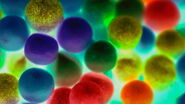How FLIM Microscopy Helps to Detect Microplastic Pollution

The use of autofluorescence in biological samples is a widely used method to gain detailed knowledge about systems or organisms. This property is not only found in biological systems, but also anthropogenic materials, such as plastics, can emit autofluorescence. Measuring the temporal resolution of this emitted autofluorescence with fluorescence lifetime imaging microscopy (FLIM) generates data on fluorescence decay, i.e. the fluorescence lifetime (τ). Our study showed that the fluorescence lifetime can be used for a label-free characterization of plastics (microplastics). The method also provides information on the size and morphology of the material. Furthermore, it could be shown that treatment at high temperature (140 - 220 °C) before measurement has a stable influence on the fluorescence intensity and can cause variations in fluorescence lifetime.




